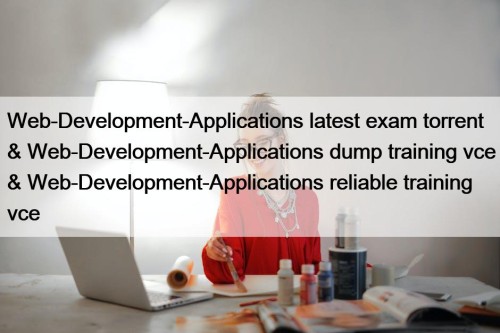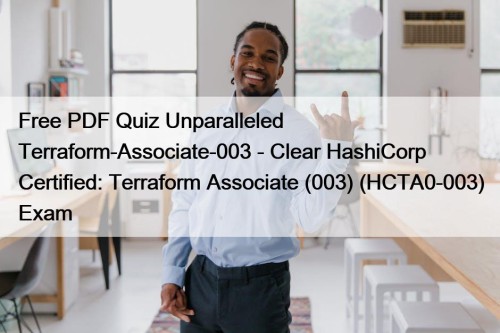Most Popular
 Providing You High-quality Test JN0-637 Topics Pdf with 100% Passing Guarantee
Providing You High-quality Test JN0-637 Topics Pdf with 100% Passing Guarantee
TestPDF IT expert team take advantage of their experience and ...
 Web-Development-Applications latest exam torrent & Web-Development-Applications dump training vce & Web-Development-Applications reliable training vce
Web-Development-Applications latest exam torrent & Web-Development-Applications dump training vce & Web-Development-Applications reliable training vce
UpdateDumps provide people a relatively short period of time with ...
 Free PDF Quiz Unparalleled Terraform-Associate-003 - Clear HashiCorp Certified: Terraform Associate (003) (HCTA0-003) Exam
Free PDF Quiz Unparalleled Terraform-Associate-003 - Clear HashiCorp Certified: Terraform Associate (003) (HCTA0-003) Exam
We know the certificate of Terraform-Associate-003 exam guide is useful ...



[Genuine Information] HP HPE7-A06 Exam Questions with 100% Success Guaranteed

The quality of the HPE7-A06 exam product is very important. A high-quality HPE7-A06 exam study material can save your time spent on the study and can also enhance your confidence. Here, our HP HPE7-A06 exam vce dumps will be the right study material for you. HPE7-A06 Training Pdf cannot only help you pass your exam, but also widen your horizons. Then passing the HPE7-A06 exam test is a certain thing. Equipped with the skills of HPE7-A06 certification, you will have more opportunity in your career.
Many customers may doubt the quality of our HPE7-A06 learning quiz since they haven't tried them. But our HPE7-A06 training engine is reliable. What you have learnt on our HPE7-A06 exam materials are going through special selection. The core knowledge of the real exam is significant. With our guidance, you will be confident to take part in the HPE7-A06 Exam. Our HPE7-A06 study materials will be your good assistant. Put your ideas into practice.
>> HPE7-A06 Certification Exam Dumps <<
From HPE7-A06 Certification Exam Dumps to HPE Campus Access Switching Expert Written Exam, Quickest Way for Passing
The free demos do honor to the perfection of our latest HPE7-A06 exam torrent, and also a performance of our considerate after sales services. Those demos serve as epitomes of real HPE7-A06 quiz guides for your reference. In our demos, some examples or question points were enumerated as some representatives of our HPE7-A06 Test Prep. How convenient and awesome of it! By the free trial services you can get close realization with our HPE7-A06 quiz guides, and know how to choose the perfect versions before your purchase.
HPE Campus Access Switching Expert Written Exam Sample Questions (Q59-Q64):
NEW QUESTION # 59
Which tables arc synchronized between a pair ofCX 8325 switches in a VSX cluster? (Select two.)
- A. BGP Neighbors
- B. MAC address
- C. Spanning-TreeProtocol (STP)
- D. Link Layer Discovery Protocol (LLDP)
- E. IP Routing
Answer: B,E
Explanation:
The question asks which tables are synchronized between a pair of CX 8325 switches in a Virtual Switching Extension (VSX) cluster. VSX is a high-availability solution that synchronizes specific tables to ensure consistent operation across both switches.
* Analysis of Options:
* A. BGP Neighbors:BGP neighbor tables are not synchronized in VSX; each switch maintains its own BGP sessions.
* B. MAC address:Correct. VSX synchronizes the MAC address table to ensure consistent Layer
2 forwarding across both switches.
* C. Spanning-Tree Protocol (STP):STP states are not synchronized; each switch runs its own STP instance, though they coordinate to avoid loops.
* D. IP Routing:Correct. VSX synchronizes the IP routing table to ensure consistent Layer 3 forwarding.
* E. Link Layer Discovery Protocol (LLDP):LLDP information is not synchronized; each switch maintains its own neighbor information.
* Why B and D are Correct:In a VSX cluster, the MAC address table and IP routing table are synchronized to ensure seamless Layer 2 and Layer 3 operations. This synchronization allowsboth switches to share a common view of the network, enabling features like active-active forwarding and hitless failover. The vsx-sync feature in AOS-CX ensures these tables are kept consistent across the VSX pair.
* Relevance to Certification Objectives:
* Network Resiliency and Virtualization (8%):Involves designing and troubleshooting VSX for resiliency and redundancy.
* Switching (19%):Includes implementing and troubleshooting Layer 2 technologies like MAC address tables.
* Routing (16%):Covers IP routing table synchronization in VSX environments.
References:
HPE Aruba Networking AOS-CX Configuration Guide: VSX Configuration, detailing table synchronization.
HPE7-A06Study Guide: Covers VSX architecture and synchronization mechanisms.
HPE Aruba Networking Technical Documentation: VSX Overview, explaining MAC and routing table synchronization.
VSX (Virtual Switching Extension) synchronizes state information between the two switches in a cluster to enable active-active forwarding and provide a single logical view to downstream devices.
Analysis of Options:
A: BGP Neighbors: BGP sessions are typically established independently by each VSX member. While configurations can be synced, the dynamic state/neighbor table itself is not a core VSX synchronization item.
B: MAC address: The MAC address table is synchronized between VSX members. This is crucial for Layer 2 forwarding consistency and allowing either switch to forward traffic destined for a known MAC address learned via the VSX pair.
C: Spanning-Tree Protocol (STP): STP runs independently on each physical switch. VSX uses technologies like MC-LAG to provide loop-free active-active paths downstream, reducing reliance on STP blocking, but the STP state itself isn't synchronized via the ISL.
D: IP Routing: While the full IP routing table (RIB) is built independently on each switch via routing protocols, VSX Active Gateway synchronizes necessary Layer 3 information (like virtual gateway IP and MAC, and potentially ARP entries) to ensure consistent first-hop routing and failover. Some sources might broadly categorize ARP synchronization under L3/IP routing context in VSX. Given that the ARP table (essential for L3 forwarding consistency) is synchronized, and it's not listed separately, "IP Routing" might encompass this synchronization aspect.
E: Link Layer Discovery Protocol (LLDP): LLDP information relates to physically connected neighbors of each switch and is not synchronized across the VSX ISL.
Conclusion: The MAC address table (B) is definitively synchronized. The ARP table is also synchronized, which is fundamental for Layer 3 forwarding consistency provided by Active Gateway. As ARP is not explicitly listed, and "IP Routing" (D) is, D is the most likely second answer intended to cover the necessary L3 state synchronization (primarily ARP and Active Gateway state) performed by VSX.
References: AOS-CX VSX Guide (specifically sections on State Synchronization, ISL, Active Gateway), VSX Fundamentals documentation. This relates to "Network Resiliency and virtualization" (8%) and
"Switching" (19%) objectives.
NEW QUESTION # 60
An IT administrator uses AOS-CX switches to send TCP 22 trafficfrom the switch port to a remoteserver for analysis. The administrator now wants to save it locally tobedownloaded and used later in case the admin changes their mind about the approach to take.
- A. destination file tshatk-pcap
- B. destination tunnel file tshark-pcpap
- C. destination flash:/.'my-mirror.pcnap policy Policy Minor22
- D. destination cpu
Answer: A
Explanation:
The question involves an AOS-CX switch administrator using a packet capture (e.g., tshark) to monitor TCP port 22 traffic and wanting to save it locally for later download, instead of sending it to a remote server.
* Analysis of Options:
* Option A:Correct. The destination file tshark-pcap command specifies that the packet capture output is saved to a local file (e.g., tshark-pcap) on the switch's flash storage.
* Option B:Incorrect. destination tunnel file tshark-pcpap is not a valid AOS-CX command for local storage.
* Option C:Incorrect. destination cpu is not relevant for saving packet captures; it may refer to CPU-based monitoring.
* Option D:Incorrect. destination flash:/.'my-mirror.pcnap policy Policy Minor22 has invalid syntax and does not align with packet capture storage.
* Why Option A is Correct:In AOS-CX, packet captures can be configured using the monitor command (e.g., monitor session 1 source interface 1/1/1 destination file tshark-pcap). The destination file tshark- pcap option saves the captured packets (e.g., TCP port 22 traffic) to a local file on the switch's flash storage, which can be downloaded later via SCP, SFTP, or the Web UI. This meets the administrator's requirement to store the capture locally for future analysis, aligning with AOS-CX's packet capture capabilities.
* Relevance to Certification Objectives:
* Troubleshooting (10%):Performing advanced troubleshooting using packet captures.
* Performance Optimization (6%):Analyzing network traffic for performance issues.
* Connectivity (9%):Diagnosing connectivity issues with monitoring tools.
References:
HPE Aruba Networking AOS-CX Configuration Guide: Packet Capture and Monitoring, detailing file-based captures.
HPE7-A06Study Guide: Covers troubleshooting with packet analysis tools.
HPE Aruba Networking Technical Documentation: AOS-CX Packet Capture Best Practices.
NEW QUESTION # 61
AnOSPF router has teamed a path to an external network oy both an El and an E2 advertisement, both routes having the same path cost. Which path -will the router prefer?
- A. The router will prefer the E1 path.
- B. The router will use both paths equally by means ofECMP
- C. Both routes will be suppressed until the path conflict has been resolved.
- D. The router will prefer the E2 path.
Answer: A
Explanation:
The question involves an OSPF router receiving both an E1 (External Type 1) and an E2 (External Type 2) advertisement for an external network with the same path cost. The task is to determine which path the router will prefer.
* Analysis of Options:
* Option A (ECMP):Equal-Cost Multi-Path (ECMP) is used when multiple paths have the same total cost, but E1 and E2 routes have different metric calculations, so ECMP does not apply here.
* Option B (Prefer E2):Incorrect, as E2 routes are preferred only when E1 routes are not present or have a higher total cost.
* Option C (Suppressed):OSPF does not suppress routes due to path conflicts; it selects the best path based on metrics.
* Option D (Prefer E1):Correct. OSPF prefers E1 routes over E2 routes because E1 routes include the internal cost to the ASBR (Autonomous System Boundary Router) plus the external cost, providing a more accurate total cost.
* Why Option D is Correct:In OSPF, external routes are advertised as E1 or E2. E1 routes include both the external cost (advertised by the ASBR) and the internal cost to reach the ASBR, making them more precise for path selection. E2 routes only consider the external cost and are the default for redistributed routes unless explicitly configured as E1. When an OSPF router receives both E1 and E2 routes with the same external cost, it prefers the E1 route because it accounts for the total path cost, including internal network topology. This is per OSPF standards (RFC 2328).
* Relevance to Certification Objectives:
* Routing (16%):Involves designing and troubleshooting OSPF routing topologies, including external route types (E1 vs. E2).
* Troubleshooting (10%):Includes analyzing OSPF path selection to resolve routing issues.
References:
HPE Aruba Networking AOS-CX Configuration Guide: OSPF Configuration, detailing E1 and E2 route types.
HPE7-A06Study Guide: Covers OSPF external route selection and path preference.
RFC 2328: OSPF Version 2, explaining E1 and E2 route metrics and preference.
NEW QUESTION # 62
Refer to the four numborod slops in the exhibit.
Which action is the fourthstep in applying a role-to-role ACL on thetraffic from mobile device M1 to roleH2?
- A. Gateway 1 forwards thetraffic over the sialic VXLAN tunnel to the edge switch; this packet carries the Group Policy ID corresponding to the role ofM1.
- B. The edge switch acts as the intermediate node and transfers the Group Policy ID over static VXLAN to dynamic VXLAN tunnel and forwards the packet to switch Al.
- C. The AP forwards the packet from M1 to gateway 1.
- D. Switch A1 determines the destination role based on destination MAC or destination IP and enforces role-to-role ACLs.
Answer: D
Explanation:
The question asks for the fourth step in applying a role-to-role ACL on traffic from a mobile device (M1) to a role (H2) in a network using Dynamic Segmentation with VXLAN. This follows question 17, which identified the first step as the AP forwarding the packet to the gateway.
* Analysis of Options:
* Option A:Correct. The fourth step involves the destination switch (Switch A1) determining the destination role (H2) based on the destination MAC or IP address and applying the role-to-role ACL to permit or deny the traffic.
* Option B:Describes an earlier step (likely second or third) where the gateway forwards traffic over a VXLAN tunnel.
* Option C:Describes the first step, as identified in question 17.
* Option D:Describes an intermediate step (likely third) where the edge switch transfers the Group Policy ID over VXLAN.
* Why Option A is Correct:In HPE Aruba Networking's Dynamic Segmentation architecture, the traffic flow for role-based ACLs in a VXLAN environment follows these steps:
* The AP forwards the packet from M1 to the gateway (question 17).
* The gateway assigns the source role (M1's role) and forwards the packet over a VXLAN tunnel with the Group Policy ID.
* The edge switch transfers the Group Policy ID to the destination switch (A1) via VXLAN.
* Switch A1 determines the destination role (H2) based on the destination MAC or IP address and enforces the role-to-role ACL, as defined in the Group-Based Policy (GBP).
The fourth step is critical for policy enforcement, ensuring that traffic complies with the security policies defined between the source and destination roles, providing secure network segmentation.
* Relevance to Certification Objectives:
* Security (10%):Designing and troubleshooting role-based security policies in customer networks.
* Switching (19%):Implementing Layer 2/3 interconnection technologies like VXLAN for policy enforcement.
* WLAN (9%):Troubleshooting wireless traffic flows in Dynamic Segmentation.
References:
HPE Aruba Networking AOS-10 Configuration Guide: Dynamic Segmentation and VXLAN, detailing role- based policy enforcement.
HPE7-A06Study Guide: Covers Group-Based Policy and Dynamic Segmentation workflows.
HPE Aruba Networking Technical Documentation: Tunneled Node and Role-Based ACLs.
NEW QUESTION # 63
Which minimal configurations must becompleted for MSTP to work correctly? (Select two.)
- A. MSTP enabled interfaces
- B. creating MSTP instances
- C. bridge priority number
- D. revision number
- E. MSTPregion
Answer: D,E
Explanation:
The question asks for the minimal configurations required for Multiple Spanning Tree Protocol (MSTP) to work correctly on AOS-CX switches.
* Analysis of Options:
* Option A:Correct. The MSTP region name must be configured to define the MSTP region and ensure switches belong to the same region.
* Option B:Incorrect. Bridge priority is optional and defaults to 32768; it's not mandatory for MSTP functionality.
* Option C:Correct. The MSTP revision number is required to ensure consistency across switches in the same region.
* Option D:Incorrect. Enabling MSTP on interfaces is automatic for VLAN-enabled ports; explicit configuration is not mandatory.
* Option E:Incorrect. Creating MSTP instances is optional and only needed for specific VLAN-to- instance mappings.
* Why A and C are Correct:MSTP requires a consistent region configuration across all switches to function correctly. The minimal configuration includes:
* MSTP region name:Defines the region (e.g., spanning-tree config-name REGION1) to group switches.
* Revision number:Ensures region consistency (e.g., spanning-tree config-revision 1).
These settings ensure switches form a single MSTP region, allowing VLAN-to-instance mappings (default instance 0 if not specified) and loop prevention. Other settings, like bridge priority or explicit instance creation, are optional and not strictly required for basic MSTP operation.
* Relevance to Certification Objectives:
* Network Resiliency and Virtualization (8%):Designing and troubleshooting MSTP for redundancy and fault tolerance.
* Switching (19%):Implementing Layer 2 technologies like MSTP for loop prevention.
References:
HPE Aruba Networking AOS-CX Configuration Guide: MSTP Configuration, detailing region and revision requirements.
HPE7-A06Study Guide: Covers MSTP setup and best practices.
HPE Aruba Networking Technical Documentation: Spanning Tree Protocols for AOS-CX.
NEW QUESTION # 64
......
BraindumpsPass has many HPE Campus Access Switching Expert Written Exam (HPE7-A06) practice questions that reflect the pattern of the real HPE Campus Access Switching Expert Written Exam (HPE7-A06) exam. BraindumpsPass allows you to create a HPE Campus Access Switching Expert Written Exam (HPE7-A06) exam dumps according to your preparation. It is easy to create the HP HPE7-A06 Practice Questions by following just a few simple steps. Our HPE Campus Access Switching Expert Written Exam (HPE7-A06) exam dumps are customizable based on the time and type of questions.
HPE7-A06 Reliable Exam Blueprint: https://www.braindumpspass.com/HP/HPE7-A06-practice-exam-dumps.html
HP HPE7-A06 Certification Exam Dumps It will be easy for you to find your prepared learning material, Select BraindumpsPass's HP HPE7-A06 exam training materials, and it is absolutely trustworthy, Take The HPE7-A06 Exam And Pass It In First Attempt Through HPE7-A06 Exam Dumps: Everyone wants to get high scores in the first attempt, We are concentrating on providing high-quality authorized HPE7-A06 study guide all over the world so that you can clear exam one time.
Never assume that the attacker launched a single exploit from the HPE7-A06 Internet to your network, Therefore, we must have a rigorous process that permits a further clarification of the problem domain.
Efficient HPE7-A06 Certification Exam Dumps | 100% Free HPE7-A06 Reliable Exam Blueprint
It will be easy for you to find your prepared learning material, Select BraindumpsPass's HP HPE7-A06 Exam Training materials, and it is absolutely trustworthy.
Take The HPE7-A06 Exam And Pass It In First Attempt Through HPE7-A06 Exam Dumps: Everyone wants to get high scores in the first attempt, We are concentrating on providing high-quality authorized HPE7-A06 study guide all over the world so that you can clear exam one time.
If you really want to get an international certificate, HPE7-A06 training quiz is really your best choice.
- Pass4sure HPE Campus Access Switching Expert Written Exam certification - HP HPE7-A06 sure exam practice 🏚 Open [ www.passtestking.com ] enter 《 HPE7-A06 》 and obtain a free download 😲HPE7-A06 Exam Revision Plan
- Reliable HPE7-A06 Test Sample 🕤 Exam HPE7-A06 Simulator Online ⏪ HPE7-A06 Pass Guarantee 📓 Copy URL 《 www.pdfvce.com 》 open and search for 【 HPE7-A06 】 to download for free 🎾HPE7-A06 Valid Exam Pdf
- Useful HPE7-A06 Certification Exam Dumps Provide Prefect Assistance in HPE7-A06 Preparation 🪓 Search for 《 HPE7-A06 》 and easily obtain a free download on ▛ www.real4dumps.com ▟ 🛒HPE7-A06 Training Kit
- High Quality HPE7-A06 Guide Torrent: HPE Campus Access Switching Expert Written Exam Help You Get Certification - Pdfvce ☘ Easily obtain free download of ➠ HPE7-A06 🠰 by searching on ▶ www.pdfvce.com ◀ 🌄HPE7-A06 Reliable Dumps Pdf
- HP HPE7-A06 Certification Exam Dumps Are Leading Materials - HPE7-A06 HPE Campus Access Switching Expert Written Exam ♻ Go to website ▶ www.passcollection.com ◀ open and search for ✔ HPE7-A06 ️✔️ to download for free 📹Exam HPE7-A06 Simulator Online
- HPE7-A06 Exam Revision Plan 🏐 New HPE7-A06 Braindumps Ebook 🏘 Reliable HPE7-A06 Test Sample 🍅 ➡ www.pdfvce.com ️⬅️ is best website to obtain ⮆ HPE7-A06 ⮄ for free download 💻Exam HPE7-A06 Certification Cost
- Pass4sure HPE Campus Access Switching Expert Written Exam certification - HP HPE7-A06 sure exam practice 🧼 Search for ➽ HPE7-A06 🢪 and obtain a free download on { www.lead1pass.com } 😂HPE7-A06 Reliable Test Experience
- High Quality HPE7-A06 Guide Torrent: HPE Campus Access Switching Expert Written Exam Help You Get Certification - Pdfvce 💧 The page for free download of ▷ HPE7-A06 ◁ on { www.pdfvce.com } will open immediately 🦺Learning HPE7-A06 Materials
- Pass4sure HPE Campus Access Switching Expert Written Exam certification - HP HPE7-A06 sure exam practice 🤗 Enter ▛ www.exam4pdf.com ▟ and search for ▛ HPE7-A06 ▟ to download for free 🎈Valid HPE7-A06 Exam Tips
- HPE7-A06 Pass4sure vce - HPE7-A06 Updated Training - HPE7-A06 prep practice ⚠ Open website { www.pdfvce.com } and search for ▶ HPE7-A06 ◀ for free download 🏃Reliable HPE7-A06 Test Sample
- HPE7-A06 Reliable Braindumps Ebook 🧔 Latest HPE7-A06 Exam Cost 🍧 New HPE7-A06 Braindumps Ebook 🔢 Copy URL ▛ www.pdfdumps.com ▟ open and search for ➤ HPE7-A06 ⮘ to download for free ⭕HPE7-A06 Mock Test
- HPE7-A06 Exam Questions
- club.campaignsuite.cloud adrcentre.org skills.starboardoverseas.com upsccurrentonly.com nycpc.org bexcellent.academy rowdymentor.com lms.sgi.org.in skillsacademy.metacubic.com courses.redblackofficials.com
Tags: HPE7-A06 Certification Exam Dumps, HPE7-A06 Reliable Exam Blueprint, Free HPE7-A06 Learning Cram, Study HPE7-A06 Material, HPE7-A06 Sample Questions Pdf